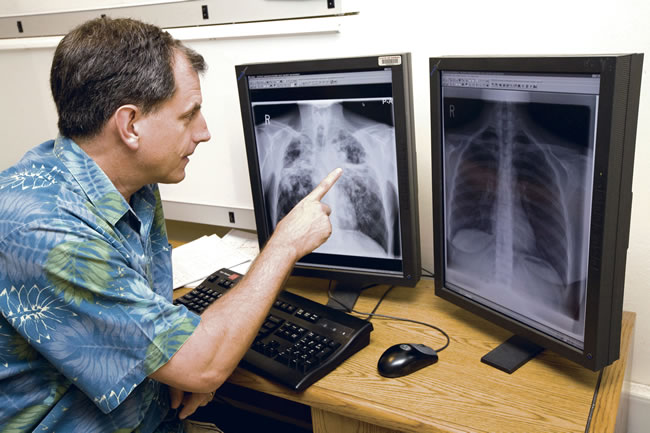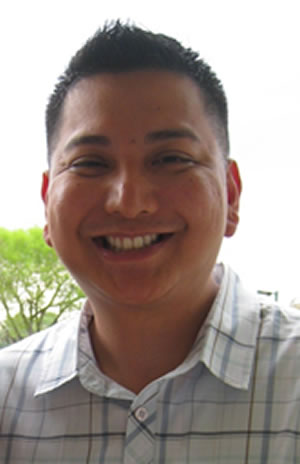Tackling Tuberculosis
Dr. Richard Brostrom & Derrick Felix
Where did you receive your schooling and training?
Brostrom: I went to Viterbo University in Wisconsin and then the University of North Carolina for a public health degree followed by a medical degree. I did three years of family practice training and got my board certification in Tacoma, Wash. I worked on TB cases in a Navajo Indian reservation for two years, and then I spent 15 wonderful years working with TB patients in Saipan. I left that post last year for a federal Centers for Disease Control position here in Hawaii. I am the Department of Health’s tuberculosis branch chief.
Felix: I did my undergrad in health education at the University of Florida. I worked for the health department in Palm Beach County and started my public health career working in a tuberculosis program in West Palm Beach. I then worked with the Centers for Disease Control as a public health adviser. I was transferred to Hawaii in 2005 and I am a senior public health adviser with the Department of Health.
How prevalent is TB in Hawaii?
Brostrom: We screen approximately 25,000 residents here at Lanakila Clinic every year. Very few of those are actually tuberculosis cases. A fair number have been infected with TB and have a skin test that’s positive. For those that have a positive skin test, we’ll look even further and do an X-ray. Among those we’ll find around 120 or so TB cases every year. It’s been pretty steady for the past five years. We also have screening on the Neighbor Islands. All together we’re responsible for the screening of nearly 50,000 people every year.
How have TB mortality rates changed in the past 100 years?
Brostrom: Go back to the 1920s and it was a few thousand deaths per year here in Hawaii. In the 1940s with the advent of TB medication, there were around 400 to 500 deaths per year. We now average one or two TB deaths per year. So we’ve gone from 400 deaths to just one or two per year.
Felix: If TB is caught and diagnosed soon enough, treatment is very successful. We cure the majority of our cases. As far as the unfortunate deaths, typically those are due to delayed diagnosis and there are certain situations where TB was only diagnosed after the person had died.
Who is at risk for TB?
Felix: Hawaii has the highest rate of TB cases in the nation. It’s double the national average. Annually, approximately 90 percent of the cases diagnosed in Hawaii are foreign-born and 50 percent were born in the Philippines.
Brostrom: TB is one of the diseases of highest concern in the Pacific. Our populations of high concern are the Philippines and Micronesia.
Felix: It’s important to point out that annually we diagnose around 15 TB cases among people born in Hawaii and the U.S. mainland. This is around the same number we diagnose among persons born in Micronesia every year.
What is TB? What are the symptoms, what’s happening in the body?
Felix: TB is typically a disease that is in the lungs, but it’s not isolated to the lungs. TB also can be found in other parts of your body as well. We have cases where people have it in their kidneys, their brain or their spine. It’s only when TB is in the lungs that it can be transmitted to other people. Anytime a person with TB in their lungs coughs or speaks or breathes, the bacteria get expelled into the air. Anyone who is around that person for a prolonged period of time and in a fairly closed space, has a higher risk of breathing in the bacteria. Typical symptoms include a cough that lasts for a few weeks, weight loss and nighttime fevers. It’s important to see your doctor if you have symptoms like this.
Brostrom: Even though it’s been around a long time, TB remains a challenging disease for doctors. In Hawaii, as everywhere, we see patients who have bounced from one clinic to another before someone finally settles on the diagnosis of TB. That’s a function of the fact that TB is a tricky disease, and that TB is coming under better control each year, so doctors are seeing less and less of it. That makes our job to do outreach and education with the local physicians even more important.
Why is TB the only disease that has mandatory testing for schools and jobs?
Brostrom: It’s partly because TB can be pretty contagious in a small classroom, and difficult to treat … though we do have lots of success with TB treatment. It’s also a function of how serious TB was in the past that we have laws that are set up to make sure that it doesn’t spread in the community. The TB program has an important place in the Department of Health, and we are well-supported by the state of Hawaii.
What constitutes treatment?
Brostrom: When we find a patient, we come to the home every day to give them their medicine and we make sure they swallow it. TB is the only disease where that level of care is brought to the patient’s doorstep. That is the global standard. It’s been tremendously successful in treating TB because we take that extra step. We start with four medications, which is around nine to 10 pills every day. It’s difficult to take these pills. Although they’re the best TB medicines in the world, they do have side effects. After two months, we reduce treatment to two medications and it’s much easier on the patient. Most patients are considered cured at six months of treatment.
In Hawaii, we are part of efforts across the world to try to eradicate TB in our lifetimes. And we’ve seen tremendous strides in the last 30 to 40 years with standardization of care and with this directly observed therapy model where we hand the meds directly to the patients every day. Tuberculosis is still a disease of concern. But with early diagnosis and good medication, tuberculosis is very curable.







